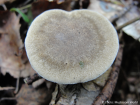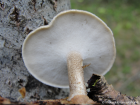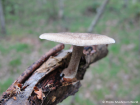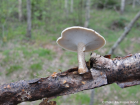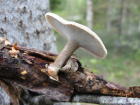Cap upper surface greyish brown or yellowish-brown, convex at first, flattening with a depressed (umbilicate) centre. Particularly towards the margin, the cap surface is usually covered in tiny bristly hairs. The flesh is white and leathery. Stem variable in colour, often pale yellowish brown or tawny-buff, more or less equal, typically curved and sometimes thickened at the base. Pores whitish cream to buff, circular, elongating with age. Spore print white.
Microscopic Features: The spores are subcylindrical, often slightly allantoid, smooth, measuring 5-6 x 1.5-2.5µm, and are inamyloid.
Polyporus ciliatus on the www.first-nature.com web site.
Many mushrooms are poisonous, and some can be lethally toxic. Distinguishing between edible and poisonous mushrooms can be very challenging. Therefore, we strongly advise against consuming wild mushrooms. This website does not contain any information about the edibility or toxicity of mushrooms.
Although efforts have been made to ensure accuracy on this website, the information may contain errors and omissions. Therefore, all content provided is for educational and informational purposes only and should not be relied upon or used as a basis for consuming any plants or mushrooms.
External links are provided for reference only. We do not endorse or take responsibility for the content, advice, or products found on these sites or in any advertisements shown on this website.
